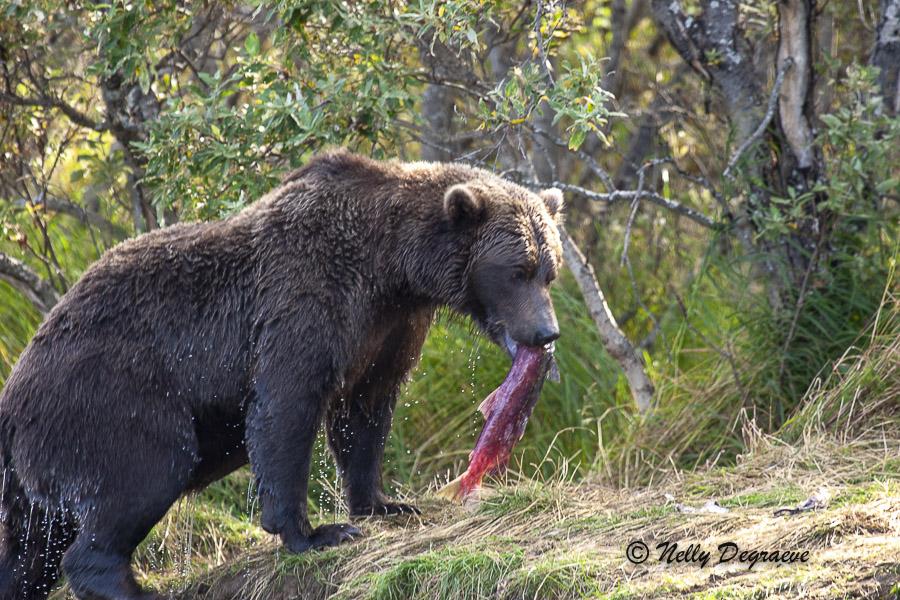Winter rest.
Faced with the cold, all animals are not equal.
Some must migrate or hibernate, others opt for hibernation.
Wintering means spending the bad season sheltered, in a place protected from frost, cold, snow.
Just like animals that hibernate, overwintering animals slow down their metabolism.
They may be in a numb state and sleep a lot.
They save their energy but do not enter a state of deep lethargy.
Overview of these wintering animals.
To discover
DOSSIER - Christmas tree: when to buy it?
Which one to choose ?
All our answers
Brown bear
During hibernation the brown bear can lose up to 1/4 of its weight.
Here, a brown bear on the beach in Hallo Bay, Alaska.
Nelly Degraeve
The brown bear (
Ursus arctos
) contrary to popular belief does not hibernate but winters well.
He puts his body in slow motion to make up for the lack of food.
This large omnivorous mammal thus lives on its accumulated fat reserves.
The plantigrade halves its breathing rate and also slows its heart rate (to 8-12 beats/minute).
But unlike the marmot, he is not in a deep sleep.
He remains on his guard and can therefore easily wake up and defend himself.
The bears can thus give birth to the cubs and nurse them during this period.
The brown bear
chooses a cave, a fault, an abandoned burrow, or else digs a den, and settles there for its winter rest.
During hibernation the brown bear can lose up to 1/4 of its weight.
It is between October and December that its hibernation begins and ends around March-April.
Brown bears live in the United States, Canada, Western Europe, Russia, in wooded and wild regions.
Size: 1.50 to 2.80 m at the withers
Weight: 80 to 700 kg
Food: fish, small mammals, animal carcasses, roots, berries and fruits, acorns, grasses, plants, insects...
To note
Each bear behaves differently, so generalizations are tricky.
Some bears will not hibernate.
Read also5 wild animals that can withstand the cold
common badger
During its hibernation, the badger has phases of awakening.
adobe-stock
The common badger (
Meles meles
) of Europe is a mammal, of the mustelidae family, which has the particularity of having a gray coat and a black and white head.
Its tail can measure 10 to 20 cm, its legs have 5 fingers and it has non-retractable claws.
It lives in plains, in forests, bushes, hedges, or in mountainous areas.
It is an omnivorous nocturnal animal, endowed with a good sense of smell and good hearing.
It settles in burrows where it digs galleries.
It can go into hibernation in a protected place from November-December and this until April of the following year.
He also makes his fat reserves.
The latter has a thickness of 3 to 5 cm.
The
badger
reduces its metabolism and sleeps a lot during this winter period.
But he too can wake up and even go on night outings!
Height: 30 cm at the withers
Weight: 8 to 20 kg
Food: small rodents (mice, voles), insects (caterpillars, beetles), earthworms, plants, nuts, mushrooms, slugs, snails, frogs
Ant
The ant has a thorax equipped with muscles that operate its legs.
adobe-stock
The ant (formicus) is an insect, belonging to the Formicidae family, which is completely transformed.
The eggs hatch into larvae, then the latter metamorphose to become breeders or workers.
Workers, unlike reproductives, do not have wings.
The
ant
has a large head with antennae, 6 legs and a thorax equipped with muscles that make its legs work.
She lives in a colony in an anthill.
In winter, it goes into
diapause
in the same way as wintering animals.
It slows down its metabolism with low temperatures and lack of food, saving its energy.
To note
There are about 1200 species in the world.
They are black, red, brown, yellow.
They also come in different sizes and weights.
honey bee
A honeybee colony can number up to 70,000 individuals.
adobe-stock
The domestic
bee, honey bee
(
Apis mellifica
) is a Hymenoptera, that is to say an insect with a complete metamophore, which has 4 membranous wings, a mouth equipped with mandibles, chewing or licking.
A social species, it lives in a colony, made up of 3 castes: the queen, the workers (or foragers) and the males (false drones).
It can count up to 70,000 individuals.
In winter, when flower nectar becomes scarce, the hive lives in slow motion: the bees gather in clusters around the queen and the reserves of honey, amassed in the summer.
They lower their body temperature.
Thus, in winter, the hive is maintained at a constant temperature of 18°C, compared to the usual 35°C.
The critical temperature for the cluster of bees is 8°C.
They beat their wings to produce heat.
Good to know
In winter, the worker bees kill or drive away the males, to have enough honey to survive during this period.
The drones are considered useless mouths, since they have already fertilized the queen in the summer.
You have to earn your share of the honey reserve!
Size: from 11 mm to 20 mm (depending on whether it is a worker, queen or drone)
Weight: 0.06g to 0.08g
Food: honey, pollen
To note
Other animals also overwinter: the squirrel, the earthworm, the opposum.







